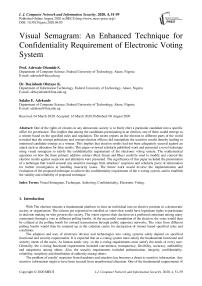Visual Semagram: An Enhanced Technique for Confidentiality Requirement of Electronic Voting System
Автор: Adewale Olumide S., Boyinbode Olutayo K., Salako E. Adekunle
Журнал: International Journal of Computer Network and Information Security @ijcnis
Статья в выпуске: 4 vol.12, 2020 года.
Бесплатный доступ
One of the rights of citizens in any democratic society is to freely elect a particular candidate into a specific office for governance. This implies that among the candidates participating in an election, one of them would emerge as a winner based on the specified rules and regulation. The recent reports on the election in different parts of the world revealed that the corrupt politicians and corrupt election officers did manipulate the sensitive results thereby leading to undesired candidate emerge as a winner. This implies that election results had not been adequately secured against an attack such as alteration for false results. This paper reviewed scholarly published work and presented a novel technique using visual semagram to satisfy the confidentiality requirement of the electronic voting system. The mathematical equations on how the three primary additive colours (Red, Green and Blue) could be used to modify and conceal the election results against suspicion and alteration were presented. The significance of this paper included the presentation of a technique that would conceal any sensitive message from attackers’ suspicion and scholarly piece of information for further investigation in handling insecurity issues. The future work would involve the implementation and evaluation of the proposed technique to achieve the confidentiality requirement of the e-voting system, and to establish the validity and reliability of proposed technique.
Visual Semagram, Technique, Achieving, Confidentiality, Electronic Voting
Короткий адрес: https://sciup.org/15017215
IDR: 15017215 | DOI: 10.5815/ijcnis.2020.04.05
Список литературы Visual Semagram: An Enhanced Technique for Confidentiality Requirement of Electronic Voting System
- Anderson, R. J., & Petitcolas, F. A. P. (2008). On the limits of steganography, Institute Electrical and Electronics Engineers (IEEE), 16, 474–481.
- Cerkez, P. S. (2013). Do you see what I see?. 2013 IEEE Applied Imagery Pattern Recognition Workshop (AIPR). Retrieved August 22, 2018 from https://ieeexplore.ieee.org/document/6749313/
- Gary, C. K. (2014). An overview of steganography for the computer forensics examiner. Retrieved on April 10, 2018 from: http://citeseerx.ist.psu.edu/viewdoc/summary?doi=10.1.1.90.8113.
- Hardikkumar, V. D. (2012). Steganography, Cryptography, Watermarking: A Comparative Study. Journal of Global Research in Computer Science, 3(12), 33-35.
- Jadhav, A. D., Ambavane, P. R., Patil, M. A., Shewale, K. G., & Vishwasrao, S. P. (2014). Online voting system based on biometrics using adhar card data. International Journal of Emerging Trends in Science and Technology, 1(2), 128–133.
- Jaya, C., Milind, K., and Pranali, T. (2017). Fingerprint based voting system. International Journal of Research in Science and Engineering, 3(2), 108–114.
- Katzenbeisser, S., & Petitcolas, F. A. P. (2000). Information hiding techniques for steganography and digital watermarking. Boston: Artech House Inc.
- Lip, Y. P., Kok, O. C., Tan, F. A., & Delina, K. (2011). An enhanced embedding method using inter-sentence, inter-word, end-of-line and inter-paragraph spacing. International Journal of the Physical Sciences (IJPS), 6(36), 8130–8142.
- Oke, B. A., Olaniyi, O. M., Aboaba, A. A., & Arulogun, O. T. (2019). Securing electronic voting system using crystographic technique. Journal of Science, Technology & Education (JOSTE), 7 (1), 88 – 105
- Olayemi, M. O., Taliha, A. F., Aliyu, A., and Olugbenga, J. (2016). Design of secure electronic voting system using fingerprint biometrics and crypto- watermarking approach. International Journal of Information Engineering and Electronic Business (IJIEEB), 8(5), 9–17, DOI: 10.5815/ijieeb.2016.05.02.
- Ragunath, G., Aarthi, R., & Dhanalakshmi, A. S. (2014). A+Votz–google android platform for a mobile - voting system with cloud based storage and data hiding features. International Journal of Engineering Development and Research, 2(2), 2318–2323.
- Shweta, A.T., Nikita, P. J., & Topannavar, P. S. (2014). Steganography and biometric security based online voting system. International Journal of Engineering Research and General Science, 2(3), 110–114.
- Suraj, K. D., & Vivek, C. (2017). Steganography, cryptography and watermarking: A review. International Journal of Innovative Research in Science, Engineering and Technology, 6(2), 2595– 2599.
- Syed, M. H., Salihah, Y., Syed, B., Mehvish, S., & Zahid, G. K. (2017). Analysis of LSB and DWT steganography techniques over various attack. International Journal of Advance Engineering and Research Development, 5(1), 1–3.
- Youssef, B. (2013). Steganography & the art of deception: a comprehensive survey. International Journal Latest Trends Computing, 4(3), 128 – 139.


